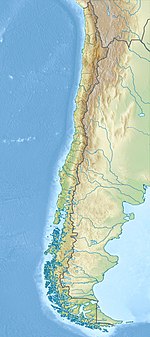The 1730 Valparaíso earthquake occurred at 04:45 local time (08:45 UTC) on July 8. It had an estimated magnitude of 9.1–9.3 and triggered a major tsunami with an estimated magnitude of Mt 8.75,[2] that inundated the lower parts of Valparaíso.[4] The earthquake caused severe damage from La Serena to Chillan, while the tsunami affected more than 1,000 km (620 mi) of Chile's coastline.[3]
| Local date | July 8, 1730 |
|---|---|
| Local time | 04:45 |
| Magnitude | 9.1–9.3 Mw,[1] 8.75 Mt[2] |
| Epicenter | 32°30′S 71°30′W / 32.5°S 71.5°W[3] |
| Areas affected | Captaincy General of Chile, Spanish Empire |
| Tsunami | Yes |
| Casualties | Unknown |
Tectonic setting
editThe earthquake took place along the boundary between the Nazca and South American tectonic plates, at a location where they converge at a rate of seventy millimeters a year.
Chile has been at a convergent plate boundary that generates megathrust earthquakes since the Paleozoic (500 million years ago). In historical times the Chilean coast has suffered many megathrust earthquakes along this plate boundary, including the strongest earthquake ever measured. Most recently, the boundary ruptured in 2010 in central Chile.[5]
Damage
editThe earthquake caused severe damage over a wide area, Valparaíso, Coquimbo, Illapel, Petorca and Tiltil were all affected. The parish church in La Serena was destroyed.
Only a few deaths were recorded due to the earthquake, reportedly because a strong foreshock had caused people to leave their homes.[3] The same is also true for the following tsunami with the inhabitants running to higher ground after seeing the water recede, so that only a few were killed.[6]
Characteristics
editEarthquake
editAt about 01:00 local time in Santiago, there was a strong earthquake, followed by several smaller tremors. The main shock occurred at 4:45 local time.[3]
A 350–550 km (220–340 mi) long rupture has been estimated for this event, from the extent of severe damage.[2]
Tsunami
editThe tsunami occurred immediately after the mainshock, with a maximum run-up height recorded at Concepción of 16 m. It was also observed at Callao, Peru[6] and in Honshu, Japan where fields were flooded in Rikuzen and the Oshika Peninsula.[7]
See also
editReferences
edit- ^ Carvajal, M.; Cisternas, M.; Catalán, P.A. (2017). "Source of the 1730 Chilean earthquake from historical records: Implications for the future tsunami hazard on the coast of Metropolitan Chile". Journal of Geophysical Research: Solid Earth. 122 (5): 3648–3660. Bibcode:2017JGRB..122.3648C. doi:10.1002/2017JB014063. S2CID 133806784.
- ^ a b c Grez, P.W.; Alvarez J.V. (2008). "Evaluacion de riesgo de tsunami en Quintero, Chile (Evaluation of tsunami risk in Quintero, Chile)" (PDF) (in Spanish). Retrieved 5 March 2010.
- ^ a b c d National Geophysical Data Center / World Data Service (NGDC/WDS): NCEI/WDS Global Significant Earthquake Database. NOAA National Centers for Environmental Information (1972), Significant Earthquake Information, NOAA National Centers for Environmental Information, doi:10.7289/V5TD9V7K, retrieved 14 April 2022
- ^ "Tsunami Hazard in the city of Valparaíso" (PDF) (in Spanish). 2008. Archived from the original (PDF) on 28 March 2023. Retrieved 5 March 2010.
- ^ "Magnitude 8.8 – Offshore Maule, Chile". United States Geological Survey. 6 March 2010. Archived from the original on 1 March 2010. Retrieved 6 March 2010.
- ^ a b NGDC. "Comments for the tsunami event". Retrieved 6 March 2010.
- ^ "The orphan tsunami of 1700" (PDF). United States Geological Survey. 2005. pp. 50–57. Retrieved 6 March 2010.

